by Winding Pathways | Sep 5, 2019 | Nature, Pests
Sometimes the best of intentions turn into a nightmare. A plant down the road from Winding Pathways is proof.
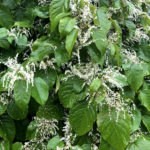
Beware the beauty of Japanese Knotweed.
In the 1840s Philipp Franz von Siebold was in Nagasaki, Japan, and believed a common native plant was so useful and interesting that it should be shared with the world. He shipped cuttings to the Netherlands. The plant thrived and soon gardeners were planting it because of its attractive reddish young leaves, hollow stems somewhat like bamboo, and its showy white flowers that bloom in September. Young shoots are even edible somewhat like asparagus in early spring.
Von Siebold thought he was doing a good thing by bringing this plant to Europe, but soon gardeners realized it was a rapidly spreading monster that crowded out more valuable vegetation. The World Conservation Union calls it one of the worst of the invasives.
It arrived in the United States in the late 1800s as a desirable garden plant, and soon it was found wild in at least 39 states. It’s an invasive problem in England, New Zealand, the United States, and many other countries.

Knotweed forms dense patches and spreads with rhizomes.
Japanese knotweed forms colonies so dense they crowd out all other plants. Rhizomes spread horizontally under the soil surface and soon new plants pop up from them. Early spring shoots have a reddish cast. Leaves are triangular, and the plants quickly grow to four or five feet tall. They are amazingly abundant along streams and lakes. In Iowa, we often see them along roads. They are especially easy to spot when their showy white blooms form in late August and continue into September.
Knotweed is an edible plant in early spring, but anyone with a garden or natural area should be cautious about bringing it home. Drop a node on the ground and it will soon sprout and grow and grow and spread and spread.
Once established Knotweed is hard to control, although continuous mowing should knock it back. It’s something to keep out of the yard, and so far, we’ve been successful at Winding Pathways.
by Winding Pathways | Dec 13, 2018 | Garden/Yard, Pests
Lots of boxelder bugs are traipsing through homes this winter to the consternation of human occupants. We reluctantly share our home with a few during cold months.
This amazingly common and crafty insect is a true bug named for common boxelder tree. You don’t have to have boxelder trees nearby to “enjoy” visits by the bug. Maples and ash trees of several species make suitable hosts. Since these trees are everywhere in suburbia it’s no wonder boxelder bugs pester so many people. The insect makes its living feeding on tree seeds and sap yet poses no threat to its host. Unlike the pests of many other trees, boxelder bugs don’t kill trees.
Come fall box elder bugs prepare for cold weather by tucking themselves into bark crevices to patiently wait out the cold. However, they would rather be warm. If a house is nearby, they seem to sense that soon the furnace will be going and indoors is the best place to overwinter.
How Boxelder Bugs Get In
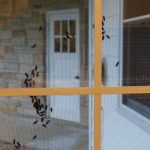
All this winter box elder bugs have gathered on warm sunny sides of homes.
Although they are fairly large insects boxelder bugs can crawl through tiny cracks and holes. Often, they swarm in the sun on the exterior of a house and some manage to find their way inside. Winter is spent idly exploring light fixtures, furniture, and walls.
They are not really a serious pest. Pesky might be a better way to describe them. Boxelder bugs neither bite nor sting. They do sometimes crawl on people and pets. Perhaps their most disagreeable characteristics are pooping and emitting a disagreeable odor if they are crushed. It’s this bad odor that protects them from predators. Hardly anything will eat a boxelder bug.
Getting Rid of Boxelder Bugs in Your Home
Want to rid the house of boxelder bugs? The best defense is a caulking gun. Late each summer seal up cracks that allow them to squeeze into the house. Look for cracks and holes around window and door frames and around wires and pipes leading into the home. Bugs discovered wandering around inside can be vacuumed up, and a shop vac can suck up hundreds sunning on the exterior. Dump them in soapy water and they’ll quickly drown. A hose can also knock them off an exterior wall. Insecticides kill them but perhaps create more problems than they solve. Some people report that spraying them with soapy water also kills them.
We’ve had some success at Winding Pathways in reducing the number of bugs we pick off walls and windows in the winter. We used to bring in a week’s worth of firewood and stack it near the woodstove. For years we didn’t realize boxelder bugs were hiding in the wood. Once they warmed up the insects set out exploring the house. Now we leave wood outside and only bring in a few pieces that go directly into the stove. It’s reduced, but not eliminated, the number of boxelder bugs inside.
Boxelder bugs aren’t harmful, but they are pesky and goofy. Caulking a home’s cracks can encourage them to winter outdoors in trees, rather than in homes. One speaker on Science Fridays quipped, “Boxelder bugs have nowhere to go and all day to get there.”
by Winding Pathways | Nov 29, 2018 | Garden/Yard, Mammals, Pests
After a balmy fall, the television weather report promised near record cold and snow in three or four days. Mice don’t have televisions but somehow, they knew this because several of the tiny mammals successfully entered our house just before cold arrived. One scurried across the floor as we were reading the morning newspaper.
Years ago we read our then young children a delightful book about a mouse in the house. The story goes: “There is a mouse in the house. It is a very nice mouse. It has a long, long tail and shiny eyes. My mother likes the mouse. But, she says, ‘A mouse does not belong in a house.’”
We agree and have developed a strategy to keep them out – at least most of them.
One tactic we do not do is poison. Karla Bloem of the International Owl Center in Houston, MN, reminds us that poison spreads. When a predator eats a poisoned mouse, it absorbs the poison. Over time, the poison builds up and kills the predator. People end up with more mice that can cause problems.
Here’s what we do at Winding Pathways:
- Encourage predators. We love to hear the barred owls call on dark evenings, and occasionally we spot a red-tailed hawk in a tree out the window. Both are outstanding mouse catchers. Owls work the night shift and hawks the day.
- Keep food secure. If mice smell dinner they’ll come right in uninvited and help themselves. It’s important to never leave food out unprotected. We store grain, flour, pasta, cookies and other foods in metal or stout plastic containers with tight-fitting lids. We don’t leave fruits and vegetables on countertops.
- Tighten up the house. Before it gets cold, we check our house over carefully. Any narrow cracks get filled with caulk. If we find a wider crack, we fill it with expanding foam. Often entry points for mice and insects are around pipes and wires leading into the home. Caulk and expanding foam help seal off the entry. Drain pipes sometimes are entry points. “Chore Girl” type metal cleaning pads work great for filling pipes where liquids or air needs to come and go. Wad up the metal pads and jam them into the pipe. Spaces in the cleaning pads let air and moisture enter or leave but keep mice out.
- Bring out the traps. Despite our best efforts, some mice make it into the house. Usually, we don’t see them but do see their calling cards – their tiny black droppings.
Effectively setting traps
Old fashioned mouse traps still catch mice efficiently, but a few tricks make success more likely. (With the exception of the poison information in this website, we have found this information to be appropriate.)
Bait. Probably the best bait is peanut butter. It just takes a tiny dab on the trigger to work.
Placement. Where you set traps is important. Mice naturally run along walls and dart under counters if they can. Traps set in the middle of a room are less likely to catch mice than those set along a wall with the trigger on the wall side.

Place several mouse traps where mice tend to enter.
Double up. It’s usually most effective to set several traps in the same spot. So, set two or three touching each other. The first trap or two might not catch the mouse. Usually one will
Keep setting the traps until you catch no more mice. Often people assume they have one mouse, but likely, there are more. Keep trapping until they’re all gone. We dispose of dead mice by simply tossing them outside for our local opossum to eat. They can be flushed down the toilet. Always be sure to wash your hands after handling mice or traps.
by Winding Pathways | Sep 27, 2018 | Bugs, Nature, Pests
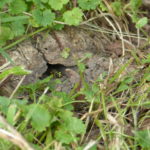
Yellow Jackets work the day shift.
We were recently concerned to find a Yellow Jacket nest close to our front door. Normally we appreciate their ambitious work catching insect prey. If they had made their nest in an out of the way place, we would have left them alone. But, their nest location invited painful stings to us or visitors. They had to go.
Several species of Yellow Jackets live in the United States. Most make an underground nest that can have an opening on the soil surface upwards of an inch in diameter. It can be nearly anywhere, but the nest we found was beneath the lawn next to the walkway into the house.
Yellow Jacket queens overwinter and begin laying eggs in the spring. By late summer or fall, the few Yellow Jackets that were around in spring have multiplied into colonies that can have hundreds of individuals. The workers die in late fall.
Many people discover a Yellow Jacket nest when they walk by it or mow the lawn over the entrance. Angry insects instantly attack and often a hapless person is stung many times in a second or two. Stings really hurt. It’s happened to us more than once, so now we don’t tolerate a nest near the house.
We only kill a Yellow Jacket colony if it’s located where we, or visitors, might be stung. Here’s how we do it:
Yellow Jackets work the day shift. Although they sometimes are out flying in the early evening by dark the entire colony is home underground in the nest. The nest entrance is easily spotted during the day by dozens of Jackets coming and going. We note its location. After dark we approach with a flashlight, spray can of insect killer, and a piece of cardboard, a board, or an old hunk of carpet. The flashlight helps find the hole. We spray a generous amount of poison down the hole, cover it with the carpet, board, or cardboard and weight it down with a rock. The covering keeps the spray in the nest.
The next morning, we watch for Yellow Jacket activity. Usually, there is none, telling us we destroyed the colony. We remove the covering, but if we see some Yellow Jackets we respray at night and cover the nest again. That usually solves the problem.
by Winding Pathways | Aug 23, 2018 | Pests
Lyme Disease Has Spread
According to National Public Radio physicians in all 50 states have reported treating cases of Lyme Disease. It is named for the town of Lyme, Connecticut, where it was first identified in the 1970s.
At first, the disease was confined mostly to the Eastern States and parts of the upper Midwest, but it has since spread widely, and the Center for Disease Control considers it one of the fastest spreading vector-borne diseases. Lyme Disease can cause fatigue, joint pain, and serious long-term problems. It is spread to people bitten by a tick so tiny that often the victim never sees it.
What’s Up With the Fatigue?
Rich contracted Lyme Disease in 2015 and again in 2018 and was successfully treated by Cedar Rapids Physician, Mary Anne Nelson, both times. His experience may help anyone who may have contracted the disease enjoy recovery from the disease. A major symptom can be fatigue.
“In 2015 I felt utterly fatigued for weeks on end. I never saw a tick or had a rash so didn’t suspect Lyme Disease. Because I wasn’t terribly sick I delayed going to Dr. Nelson until I started having knee joint pain. She prescribed a blood test that was positive for Lyme and treated it with powerful antibiotics. Fortunately, the medication worked, I had no side effects from the medication, and after a couple of months my energy returned as the joint pain faded,” he said.
Return of Lyme Disease
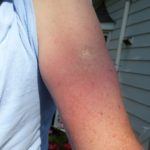
A common symptom is a generalized rash that is warm to the touch.
In 2018 a pinkish rash appeared on Rich’s left shoulder along with shoulder joint pain.
He immediately visited Dr. Nelson. She prescribed antibiotics, skipping the blood test. Symptoms vanished in a few weeks.
Not all Lyme victims are as fortunate as Rich and many struggle with the disease for years. Anyone who experiences the symptoms of rash, joint pain, or lethargy, even if they don’t feel terribly sick, should get to their physician right away. Early treatment may be most effective.
Hard to Detect
According to Dr. Nelson, Rich’s second round of Lyme was fairly typical. Like him, many victims are unaware they were bitten by a tick and often a pink rash is more common than the classic bullseye rash once thought to be a key symptom.
Lyme Disease isn’t restricted to people who slog through woods and prairies. The tick can lurk in yards, on golf courses, and in city parks. Although Lyme Disease is serious, remember, being in Nature offers tremendous health benefits. The risk of Lyme Disease shouldn’t discourage people from enjoying the outdoors.
Tips
Winding Pathways is concerned that people will shun the outdoors for fear of Lyme Disease. We encourage people to continue to enjoy their yards but be aware of the possibility of Lyme Disease, know its symptoms and take some precautions to ensure good health. Here are suggestions:
- Tuck long pants into socks to make it difficult for a tick to access the skin.
- Spray clothing with Permethrin. This chemical kills ticks and insects and is meant to be applied to clothing, not skin. It persists on clothes through several washings. Rich keeps a pair of permethrin-treated pants in the garage that he dons when working or walking in ticky areas.
- Purchase and wear clothing permeated with permethrin. Socks are available from Red Start Birding. A full line of clothing is available from Insect Shield. Local stores may sell permethrin treated clothes.
- After being outdoors take a sudsy shower and do a body tick check. Ticks sometimes walk on the skin for hours before biting. A tick strolling on the skin but not dug into the skin won’t cause Lyme Disease. Flush it down the toilet. Wash your hands.
- Be aware of symptoms. If a rash, lethargy, or joint pain appears get to a doctor right away.
Go Outside and play. The mental and physical benefits from contact with nature are huge. Just be tick aware.
by Winding Pathways | Aug 2, 2018 | Garden/Yard, Nature, Pests
Mugging Barberry

It’s a tough task eradicating Barberry.
One pleasant Saturday morning a couple dozen heavily armed people walked to the interior of Faulkes Heritage Woods. Their weapons were those used to help heal the forest and included thick leather gloves, lopping shears, hand saws, and clippers. They were out to defeat Japanese Barberry.
For two hours they attacked a huge patch of Japanese Barberry that had infiltrated the Woods. Grasping small ones with both hands people yanked them from the soil, shook them off and placed them so the roots would dry out and not re-root. In winter, when the Barberry has berries, the plants are placed on tarps and hauled off so the berries do not drop and root. Ones too big to pull were cut off at ground level.
Volunteers were organized by the Iowa Natural Heritage Foundation. It holds a conservation easement on the property that’s owned by the Marion City Parks Department. Park staff helped, and so did a crew of young people enrolled in AmeriCorps. Various local volunteers pulled and cut.
In Its Native Habitat, It is OK.
Just why is Japanese Barberry such an onerous plant? Actually, it’s a fine shrub in Japan and other parts of Asia where it’s native. There it has natural forces that keep its density in check. It was brought to North America as a landscaping plant because barberry is easy to propagate and transplant. It thrives in many locations, including compacted soil of building sites. It is an ideal landscape plant with one terrible trait.
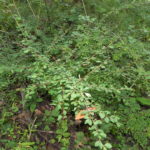
Barberry creates impenetrable tangles and changes the soil chemistry.
The plant produces red fruits in late summer that birds find delicious. They gobble them up, fly away, and poop the seeds out. So, birds snacked on barberries planted in yards and delivered the seeds into Faulkes Woods, where the seeds grow with gusto into impenetrable “pukka brush”.
Barberries crowd out native wildflowers and do much more damage. They actually change the soil chemistry to their advantage while making it less suitable for native plants. And, the dense shrubs create pockets of humidity. Each becomes an oasis of comfort for ticks.
Preserving and Exploring Faulkes Heritage Woods

Many hollows and ravines characterize Faulkes Heritage Woods.
Faulkes Heritage Woods is a gorgeous 110-acre steep forest adjoining Winding Pathways. We walk there often. Huge oaks and other native trees fill its wondrous spaces. Wildflowers abound, especially in the spring, and birding is excellent for woodland species. Pileated woodpeckers are common.
A looping footpath starts and ends at a trailhead off Tama Street Southeast. Visitors can park along the street and enjoy the woods. But, they don’t have to stick to the trail that only covers a small area. Walkers are welcome to go off trail and scramble through the woods to enjoy its beauty and solitude.
For information:
Marion Parks and Recreation: (319)447-3580
Iowa Natural Heritage Foundation: (515)288-1846
Winding Pathways LLC.









